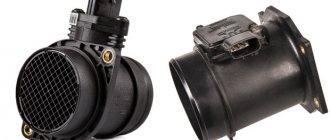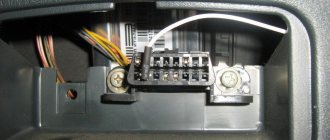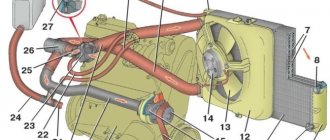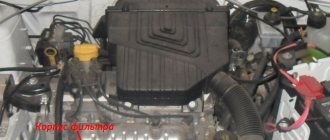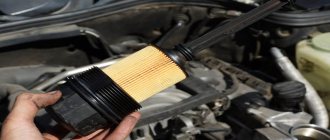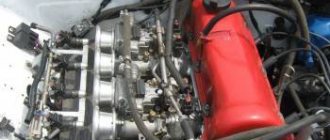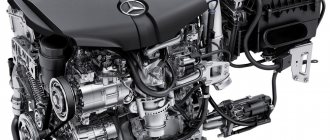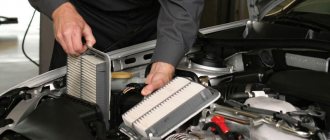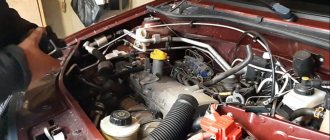Washing a car engine is included in the list of mandatory maintenance work. At the same time, there is still no consensus among car owners about whether the procedure is worth performing. There are some subtleties that not all car owners know about. That is why it is worth looking into this issue separately and deciding whether and how to properly wash the engine yourself.
Why do you need to wash the engine and engine compartment?
You need to wash your car's engine compartment once or twice a year. At the same time, answering the question of why to do this, it is worth giving the following arguments:
- a clean engine does not heat up, since dust acts as a body insulator and creates additional load on the car’s cooling system. If you wash it off, the motor will run smoothly, without interruption.
- If the engine compartment is clean, it is easier to maintain.
- In a dirty engine compartment, fires may arise from leaks of gasoline and automobile oil. For this, a simple spark or a breakthrough of exhaust gases is enough.
- Washing the engine is also necessary because it allows you to independently detect a leak on the clean surface of the power unit. As a result, it becomes possible to take timely measures without waiting for the situation to worsen.
- Before selling, the engine must also be washed in order to show the potential buyer that it works without interruption. In addition, a clean engine compartment allows him to adequately assess the technical condition of the engine.
Why is dirt under the hood dangerous?
The danger of severe contamination of the engine and its surroundings does exist, but it is slightly exaggerated.
However, there are negative factors.
- Most often, poor heat dissipation through a thick layer of dirt is mentioned, although the engine is still cooled through the radiator, and not through the outer surface of the cylinder block, head or valve cover. But some parts, such as the fuel rail, actually need to release excess heat without the participation of antifreeze.
- Under layers of road dust mixed with oil, you may not be able to see the problem. The logical question here is how often the owner will look at something there, especially if it is a modern, complex and reliable engine in a tightly packed engine compartment. But specialists will still clean their work area before work, and they will do it professionally.
- The issue of selling a used car also has two sides. A clean engine indicates the owner’s diligence in caring for the car, which gives additional points in competition with competitors. But many people know the tricks of resellers, with the help of which they thus mask the half-dead engine leaking along all the gaskets. On a dry and dusty engine, the history of the car is better visible; here it is worth emphasizing that it is slightly dusty, and not overgrown with a substance reminiscent of asphalt.
- Fire safety can also be judged from different points of view. A clean engine does not contain petroleum products that can ignite. But on the one hand, there is something to burn there even without oil flows, and on the other hand, a fire can be started precisely in the process of illiterate washing.
In any case, carry out a wet general cleaning under the hood at least occasionally, but it is necessary. This cavity of the car is poorly protected from dirt, and the more it accumulates there, the more difficult it is to wash it later. Sometimes it is simply impossible to avoid damage.
How to properly wash a car engine yourself
Washing a car engine with your own hands is not as simple a procedure as it seems. The fact is that a powerful jet of water can pierce the hood insulation; in addition, water in this case will penetrate into the spark plug wells, or under the rubber caps on the spark plugs. Also, a strong jet of liquid can rip off various covers and hanging elements located underneath.
If you do not have experience in washing the engine compartment, or you do not know how to wash a car engine with your own hands, you are better off going to a professional car wash. They have experience in performing the work and special equipment for this.
If you decide to remove existing contaminants in the engine compartment and properly wash the car engine yourself, you should adhere to the following algorithm of actions:
- First, you need to seal all the main components and assemblies of the motor so that water does not get into them. This is especially true for electrical wiring and the air filter. This can be done using plastic film and tape. It is necessary to cover all factory stickers placed on the engine.
- Then you need to clean the engine compartment from oil and dirt with a specially purchased chemical composition. To do this, a certain amount of these fluids is applied to the engine. In order for the chemicals to take effect, you need to wait the time specified in the instructions and then rinse off the detergents with a stream of water under pressure or steam under light pressure.
- When the washing procedure is completed, it is necessary to remove the protective film from the components and assemblies and thoroughly dry the engine compartment with compressed air. At home, this can be done using a regular hair dryer operating at less than full power. If you need such equipment, and you cannot quickly find a hair dryer, you can dry the motor with a vacuum cleaner.
- The work is completed by removing the resulting stains and drips using a microfiber sponge or suede cloth.
Hydrogen washing
One of the most progressive ways to clean the internal surface of the engine from contaminants is washing with a hydrogen station. A special device that generates hydrogen is connected directly to the car battery. After startup, the system begins to supply a combustible mixture entering through the air intake pipe to remove carbon deposits. Under the influence of burning hydrogen, carbon particles in the engine are separated from the walls and fly out through the exhaust system of the car.
Thus, the pistons, gas distribution mechanism, turbines and USR valves, as well as exhaust system elements, including particulate filters and catalyst, are cleaned. It is believed that the result of hydrogen washing is especially visible in cars with a diesel engine rather than a gasoline one. The cleaning process itself takes approximately 50 minutes, during which time about 100 liters of hydrogen passes through the motor. Of course, you won’t be able to clean the internal combustion engine and related systems on your own; you need competent specialists and professional equipment.
Undoubtedly, a clean engine and engine compartment ensure safe and durable operation of the car. Taking into account the mode of use and age of the car, experts recommend carrying out preventive cleaning of the internal combustion engine system at least once a year.
If you decide to wash your car engine for the first time or your car has problems after washing, consult the specialists of the FAVORIT MOTORS technical centers.
Experienced craftsmen, who constantly improve their skills with car manufacturers, will suggest the most suitable washing method or carry out all the necessary repair work with a guarantee. We use only modern equipment and original materials. You will be satisfied with the cost of services and the level of our customer service. Sign up for service Service center contacts Ask a question
How to wash a car engine
In order to find out which product will best perform the washing function, it is necessary to study in advance the technical characteristics of certain products. For example, relatively old cars have an engine compartment that is not too densely filled. As a result, you can work in it only using bottles with a hand sprayer. Their design allows for precise dosing of detergent. This makes it possible not to spend a large amount of product when washing the power unit, which is better than washing a car engine with a bucket. New cars with tight engine compartments are treated with aerosols that penetrate even hard-to-reach places.
In specialized auto accessory stores you can purchase concentrated detergents that can be used to remove the most stubborn stains. It is worth remembering that when washing the engine, it is strictly forbidden to use products that contain acids or other chemicals.
Separately, it is worth noting that the use of gasoline or diesel fuel when washing the engine is strictly prohibited in order to avoid a fire.
Tips and tricks
Almost every car wash has a warning that the staff is not responsible for the condition of your car after washing the engine. This is why you need to take care of your car yourself:
- ask the washer to cover important electronic components in your engine compartment (for example, distributor cover, fuse box, ECU, switch). To do this, you can use cling film, plastic bags and tape;
- Using a high-pressure washer, you need to wash the engine from a distance. In no case should you bring the nozzle close, as the enormous pressure can damage electrical connections and break the tightness of sealing products;
- Every self-respecting car wash should have the ability to supply compressed air. Therefore, you should definitely blow out the engine compartment, which will significantly reduce the likelihood of unpleasant consequences. Particular attention should be paid to all electrical connectors and sensors;
- After washing, especially in winter, it is advisable to let the car run for 15-20 minutes to ensure that it gets rid of moisture.
These recommendations, of course, must be followed if you want to properly wash the engine with your own hands.
Advantages of steam cleaning
The most popular way to clean the engine compartment is to wash the car engine with steam. This method of washing has a number of advantages over other means of keeping the engine compartment clean:
- there is no need to use chemical cleaning agents, which is safe for the paintwork of the engine compartment;
- the ability to clean all elements of the car at once, and not just the power unit;
- production simultaneously with washing of disinfection of the interior and engine compartment, as steam has a high temperature, at which almost all harmful microorganisms die;
- cleaning with steam is a dry car engine wash, since a car treated in this way can go on a trip immediately after all the necessary procedures have been carried out;
- steam perfectly washes away oil and fuel stains, which adds shine to chrome parts;
- steam is able to penetrate into the seams and joints of machine parts, as well as into the folds of the upholstery;
- Steam cleaning takes 30-40 minutes, which is several times faster than traditional cleaning.
To wash or not to wash the engine? Arguments of opponents and supporters
To wash the engine or not to wash it? How many people - so many opinions on this matter. The question is truly difficult, as evidenced by the number of copies broken in disputes between those who have an affirmative answer regarding the advisability of this procedure, and those who consider washing in the engine compartment a harmful and dangerous activity.
We once looked at the archives of the newspaper “Avtobusiness” , which are stored in the editorial closets, and looked through the folders on our work computers: how much has been done and written, wow! I can't even believe it! Why not remember previous publications? Moreover, many of them are useful and relevant to this day. We will mark archived articles with a special icon. We hope you will enjoy reading them on these warm summer evenings as much as we do.
In fact, serious passions are boiling over - each side has more than enough arguments. Opponents of engine washing claim that it is carried out only for the aesthetic pleasure of the owner himself, because outsiders do not even know what is being done under the hood.
No, the other side counters, the question is not only that it’s nice to look at a clean engine - dirt deposits on the engine impair its cooling and can cause overheating with all the ensuing serious consequences for the power unit.
Again, dirt is not only what rises from the road and is thrown into the engine compartment, but also leaks of fuel, oil, technical fluids, and these are a fire hazard.
To avoid overheating, you need to monitor the fluid level in the cooling system, fan, thermostat and correct any malfunctions in a timely manner, as heard in response from opponents of engine washing. If there is a standard plastic protection of the engine compartment from below, the engine will never become so covered in dirt that it has any noticeable negative effect on its proper cooling. But if electronic components, ignition system components, a starter, a generator, and a battery are flooded with water and detergents, then truly serious consequences will not be long in coming.
And oil and fuel leaks cannot ignite on their own. If we look for the source of a fire in a car, then in most cases it is faulty electrical equipment or short circuits in it. Keep the electrics in order and nothing will happen to the car. And leaks need to be eliminated by replacing leaky gaskets, seals, and pipes, but washing is no help in this matter.
After all, where in the operating instructions is engine washing listed as a mandatory car maintenance procedure? But under the hood of many cars it is easy to see warnings that it is prohibited to “desecrate” the engine compartment by washing - are the manufacturers’ instructions really not enough to forever forget about the procedure, which is not harmless to the engine?
But the “aesthetes” are not giving up this time either. Having carefully looked at the picture, they quickly find a way out of the situation: washing with high-pressure machines is prohibited, but what’s the harm in using a hose for watering the beds, and not a Karcher, before washing, wrap all potentially dangerous places of electrical equipment in cellophane, and the battery and remove it from the car altogether?
The opponents of the car wash almost faint from what they hear: it’s a good thing to remove the battery! This threatens that the standard radio will be blocked, and after returning the battery to its place and connecting it will require an access code, but it may have been lost a long time ago. In addition, all adaptation coefficients in the electronic control units will be lost, and until they are restored, which takes some time, the motor will “sausage” during operation. Perhaps we will also have to “train” the electric windows in a new way, and all this in order to make it look beautiful under the hood?
Well, the “washers” won’t stop, but sooner or later you will still have to wash the engine, otherwise, when selling the car, buyers will have enough “kondraska” as soon as they see what is happening under the hood. After all, cleanliness in the engine compartment is an indicator of the owner’s attitude towards his equipment.
But the enemies of the car wash continue to stand their ground: an engine washed before sale just arouses suspicion - why is it so clean? And then a counter-offensive follows: where, may I ask, are you going to wash the beds with a hose? On the lawn near the house? It would be better if you thought not about satisfying your aesthetic needs, but about Mother Nature. Or what - “sorry, Earth”?
Why on the lawn, those who love cleanliness are resisting under the hood, if there are many professional car washes that offer to wash the engine.
Here with “Kärcher” they are waiting for you, your counterparts continue to advance. Or are you not aware that at such car washes they warn that if something happens, the administration is not responsible for the consequences?
This throwing of the ball from one side of the field to the other can continue indefinitely, but where is the truth, which, as we know, is born in disputes? She is, as usual, in the middle.
Fears that washing may result in water penetration into electrical equipment components are not unfounded. Moisture in these components is undesirable even in minimal quantities, because it promotes oxidation, which can be fatal to electronics, and not immediately after washing, but after some time, when it is forgotten that the root cause of the breakdown should be sought in the engine that was once bathed.
However, there are components in the engine compartment that should be washed at least once a year. At least for radiators of the cooling system and air conditioning, washing is certainly useful. If their core is clogged with dirt, the normal passage of cooling air through it is disrupted. Unlike dirt deposits on the outer surfaces of the engine, clogged radiators actually threaten thermal overload and can result in engine overheating. There is another reason: protection against corrosion caused by the action of anti-icing mixtures used in winter to treat roads on the material from which radiators are made. This makes radiator cleaning, carried out at the end of the winter period of operation, highly recommended.
It is also advisable to wash the engine before carrying out repairs associated with disassembly, after which the internal cavities of the engine become accessible to dirt. What should be done in this case to eliminate the negative consequences of swimming?
As should already be clear from the above, it is necessary to wrap in cellophane all the nodes into which moisture is undesirable. There is no need to remove the battery from the car, but it won’t hurt to put some kind of plastic bag on it. What is useful for the battery is to wipe the surfaces from dirt with a rag soaked in a soda solution. The tape will help securely fasten the cellophane and also take care of the protection of stickers that may be in the engine compartment.
It is problematic to deal with dirt by simply pouring water on it. There are auto chemical products designed to clean the engine from contamination.
These preparations are applied before washing. After application, wait for the product to work on the dirt, after which you can begin water procedures.
High-pressure washing is good at removing dirt, but it is also good at pushing water into places where moisture is prohibited from entering. Therefore, it is better to refrain from using high-pressure washers. The water pressure from the hose should be gentle. It is undesirable to direct water to electrical equipment components and water them for a long time, even when wrapped in film.
At the end of washing, the cellophane is removed. There is no need to rush to start the engine. First, wipe the wiring and electrical components with a dry cloth, make sure that water has not accumulated in the spark plug wells, from where, as well as from other secluded corners, you can try to blow it out using a household vacuum cleaner, and let the engine dry for at least several hours.
It is possible that after the first start, the gasoline engine will work unstably for some time, “triple”. Most likely, water nevertheless penetrated into microcracks in the insulation of high-voltage wires and did not evaporate from the spark plug insulators, where it created conductive bridges, which caused ignition interruptions. However, if the preparation for washing and the washing itself were carried out correctly, other negative consequences from this procedure are unlikely.
Sergey BOYARSKIKH ABW.BY
Cleaning products
To properly clean the engine compartment, you need to know how to wash a car engine. You need to purchase special products, and you should not use other types of cleaners, as they can damage the paintwork of certain elements of the vehicle’s engine compartment. Separately, it is worth mentioning that washing equipment used in the washing process (for example, Karcher) should only be used together with the car shampoo that is specified in the instructions for it.
Self-washing technology
The easiest way is to entrust this work to car wash specialists. Those who did this on their own are unlikely to consider their prices for this work inflated. Especially considering the cost of the drugs used. But someone will rightly think that no one can do any job better than the owner.
What can you wash with?
Of all the means invented by motorists, it is best to focus on the use of special cleaning sprays to clean the engine. All other methods are inconvenient, unreliable, or accessible only to specialists with the appropriate equipment.
Drying the engine
After finishing the procedure, the washed engine compartment and the engine itself must be dried with a dry paper towel or rag. Moreover, if after this it is discovered that there are traces of corrosion on the elements of the engine and engine compartment, their locations must be cleaned using baking soda and water in a 1:1 ratio. The washed and treated engine should be started and run to check its performance.
Preparing the engine for washing
Before starting the engine washing procedure, it is necessary to carry out preparatory work. This is done to protect the components from unwanted moisture.
What should be done:
- remove parts that restrict access to the engine;
- disconnect the negative terminal of the battery;
- remove the engine compartment protection;
- treat nearby parts with a water-repellent aerosol;
- cover sensors, connectors and wires with polyethylene film.
This concludes the preparation for engine washing. After the work is completed, you can begin washing.
conclusions
The car engine needs to be washed, just like all its other structural elements. At the same time, when washing it, it is necessary to follow certain rules in order not to damage the power unit and the components of the engine compartment. The frequency of washing the engine is once a month and should be adhered to so that the engine not only looks neat, but is also in good working order. With a clean engine, you can see traces of fuel and oil leaks in advance, and eliminate the faults that caused them in a timely manner.
Is it possible to wash the engine in winter?
Pros:
1. Dirt and oil collected under the hood have a bad effect on the operation of electronic equipment. Electrical wiring and other electrical mechanisms may fail. Even an ignition caused by a small short circuit is likely.
2. A dirty motor is more likely to overheat than a clean one. In the lubrication system, due to the increase in temperature, the engine oil may become diluted, which will lead to boiling in the future.
3. Fire safety. In the engine compartment of a dirty engine, accumulated oil stains can ignite.
4. It is easier to sell a car with a clean engine, because presentation plays an important role.
5. Difficulties arise in engine maintenance. The owner of the car, due to contamination, may not notice malfunctions that will later lead to very serious damage.
Minuses:
1. You need to be very careful with flammable products that are intended for washing the engine.
2. In most cases, this process is poorly tolerated by foreign cars, especially from the electrical equipment side. There is a possibility that moisture will get into the electrical mechanisms despite the polyethylene covering them.
3. You must choose a car service meticulously, because the performance of your car depends on the preparedness of the specialists.
4. If cleaning the motor is done personally, poor drying is possible, which most likely will lead to a short circuit in the wiring.
It is advisable not to forget that car manufacturers allow washing the engine only in rare cases. Any car owner must determine the degree of need. It is also worth remembering that contamination will not cause as much harm as a stream of water.
If the car has an old diesel engine and a high-pressure fuel system, then you should not be afraid of cleaning the engine. Even if you completely lower it into the water, everything will be fine with it, because they have increased reliability. But gasoline engines will stop working due to contact with water. And there are no exceptions or discounts for car age.
Let's sum it up
Thus, engine washing can be carried out in winter. With the right approach, no problems will arise. You must fully adhere to the plan and follow the rules for cleaning the engine. Avoid using high pressure car washes. At the end, it is important to dry everything so that there is no liquid left anywhere. If you prefer car washes, you need to choose reliable companies with highly qualified specialists.
You can see how to wash a car engine in the video:
Which auto chemical products are suitable?
There are two types of liquids that can be used:
- Specialized. Such compositions are developed specifically for certain types of pollution. For example, if you need to remove oily deposits, then the appropriate product will do the job perfectly, but it will be useless against other contaminants. Specialized formulations are more suitable for heavy, old contaminants.
- Universal. Suitable for complex treatment, however, due to the fact that they are not directed against a specific type of pollution, sometimes it is necessary to carry out the washing again. Universal type preparations can be used if the engine is not very dirty.
Healthy! When processing it yourself, you can also use regular dishwashing detergent. It effectively removes fatty inclusions, does not contain too aggressive components (will not harm plastic and rubber components) and is inexpensive.
Detergent compositions are sold in different containers. However, if you buy a 5-liter canister, it will be very inconvenient to use (you will have to first pour some liquid into a smaller bottle). Therefore, the best option is considered to be compositions in the form of sprays, which allow you to apply the liquid evenly:
- STP 73500EN (spray). A 0.5 liter bottle is enough for several uses. The product (costs about 450 rubles) is suitable for a car, SUV or minibus. After applying the composition you need to wait 15 minutes. After this, the product will remove up to 85% of complex dirt and grease.
- Motorraum-Reiniger (spray from Liqui Moly). A container with a volume of 0.4 liters will cost 630 rubles. The drug is also applied for 15-20 minutes. During this time, it actively breaks down fatty deposits, road dust and oily stains. At the same time, as the manufacturer himself states, a 100 percent result can be achieved. However, this liquid is often counterfeited, so you need to make sure that the composition is really branded.
- LAVR. A domestic product costs about 900 rubles per 5 liters. This is a concentrate that is suitable for all types of contaminants and prevents the formation of corrosion. The composition cannot be applied in its pure form; it must first be diluted with water in a ratio of 1:3.
Healthy! Car shampoos, which are successfully used to wash the car body, are not recommended, as they often contain rather aggressive reagents.
In addition to the liquid, before processing the engine you will need foil, sponges, gloves, rags and brushes (only soft products can be used, so metal sponges should be abandoned).

